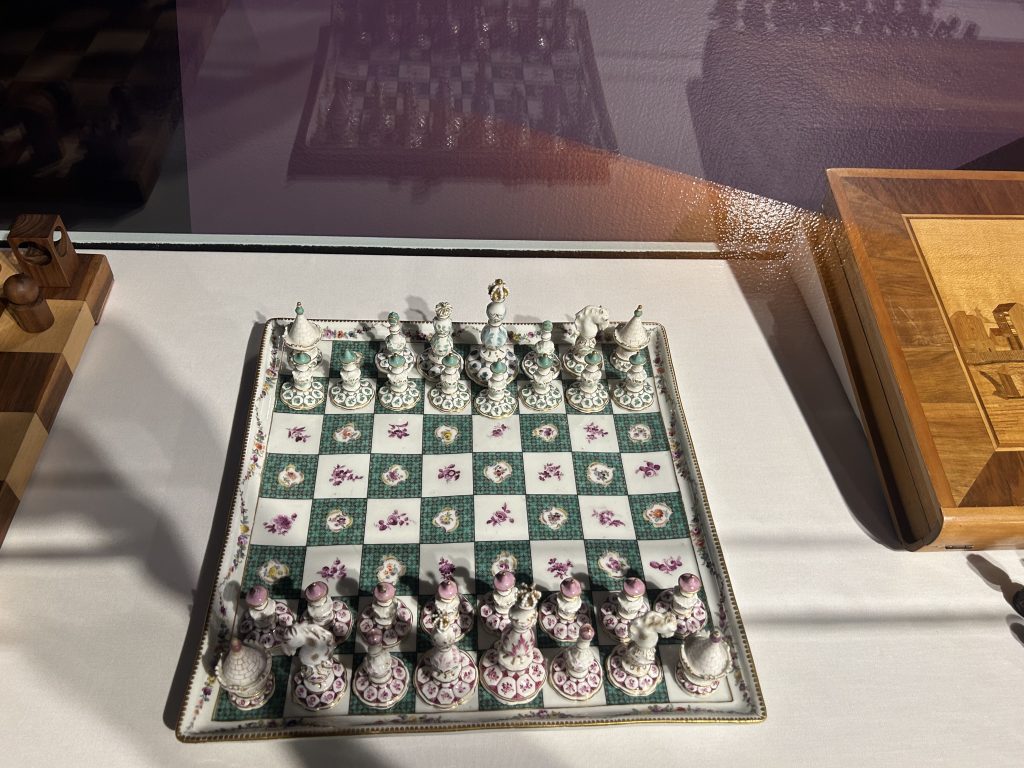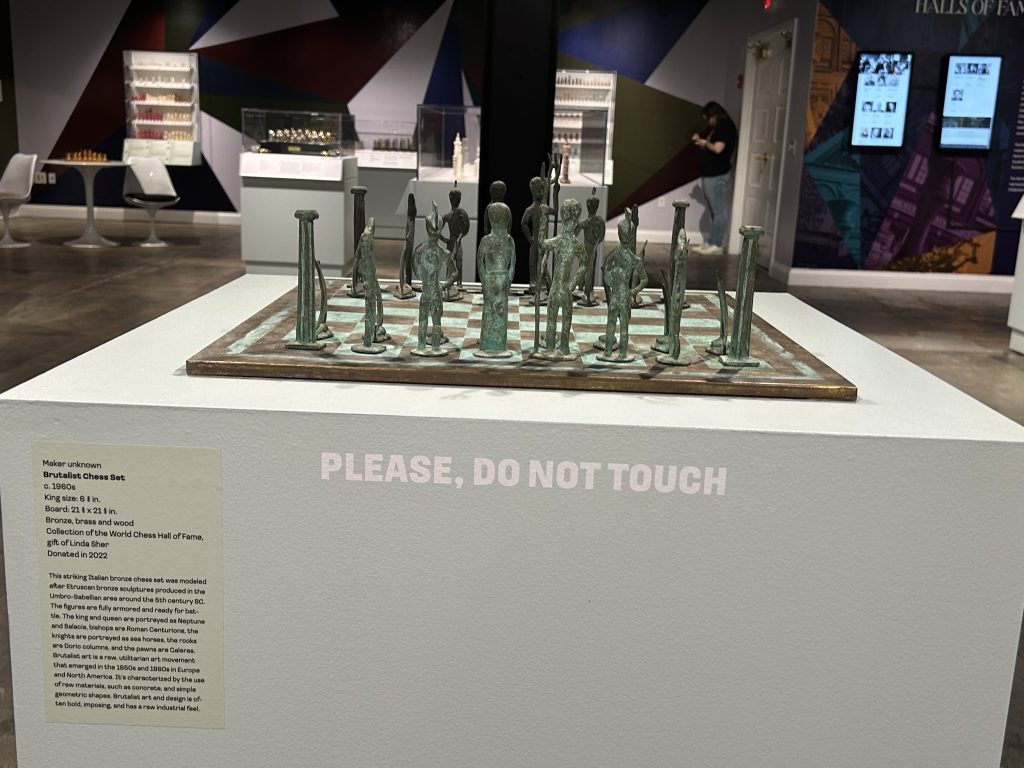The Crown Jewels: Donation Highlights exhibit at the World Chess Hall of Fame offers visitors a captivating look at the artistry and historical significance of chess through a collection of donated sets, artworks, and memorabilia. Curated by Nicole Tessmer, the exhibit showcases the generosity of Chess Collectors International members and individual donors. During my visit over the weekend, I was impressed by how the exhibit combined elegance with accessibility this free to the public exhibit is a must visit for any fan of art or chess.

Crown Jewels targets chess enthusiasts, historians, art lovers, and casual visitors interested in the intersection of strategy, craftsmanship, and history. The World Chess Hall of Fame describes the exhibit as “Donated chess artifacts reveal the artistic, cultural, and historical evolution of chess as both a game and a global phenomenon.” But I believe that Crown Jewels asks, “How is a board game so integral to the understanding of art and culture throughout the world?”
Blending artistic expression, and historical documentation, Crown Jewels highlights Chess as more than a game. Chess is community, creativity, diplomacy, and inclusion. The display includes luxurious and rare sets, such as the Hungarian Silver and Copper Enamel Chess Set and the bespoke chess set created for the Shah of Iran. The collection also includes ivory chess sets from India and China dating back to the 1800s, offering a glimpse into traditional carving techniques and material culture. These sets within the collection of the WCHOF showcase the intricacies and details that each culture used to express their life onto the board. From the tilework patterns of Islamic inspired boards, to the brutalist copper board centered in the room.

The exhibit explores multiple themes, from the evolution of chess set design to the significance of chess in different societies. Chess as fashion and in the zeitgeist are also integral pieces in the exhibit. Political and economic implications emerge through items like the 2016 Chess Olympiad Gold Medal won by the U.S. Team in Baku, Azerbaijan and memorabilia from renowned chess players such as Garry Kasparov and Emanuel Lasker. The artifacts related to Hall of Fame inductees provide a narrative linking chess history to key figures who shaped the game’s development.

While the exhibit does not have strong biases, with many cultures represented. Although chess has a large Western History, WCHOF sought out to showcase art from around the world throughout this exhibit.
One of the standout features of the exhibit is its striking design. Using a pinball-style layout, guests are able to travel fluidly around the exhibit without losing any part of the narrative. The layout allows for free movement, with well-spaced displays that invite visitors to engage at their own pace. Clear signage and thematic sections make it easy to explore the collection in an intuitive manner. Unlike strictly linear exhibits, Crown Jewels offers a more self-guided experience, which suits the varied interests of its audience.
The exhibit functions effectively, but a few potential improvements would be fixing sound issues, as the exhibit is located on the first floor, which lead to creaking from the exhibit above, creating an auditory barrier that made it hard to focus on some of the labels. Making clear marking of interactive displays, because there was a chessboard that was able to be used in the exhibit but it was not clearly marked, which meant that it could not be used to its intended intent.
The visual appeal of Crown Jewels is a standout feature. The exhibit effectively uses lighting to highlight the fine details of the chess sets, and the display cases are arranged to maximize visibility. The collection on the walls included a mix of photographs, diagrams, and textual descriptions, but the emphasis is primarily on the objects themselves.

One issue I noticed in terms of design was the didactic labeling. While the labels were generally explanatory and well-written, some were positioned too low to read easily, which could be a challenge for some visitors. Adjusting the placement of these labels would improve accessibility without compromising the overall aesthetic of the exhibit.

The balance between text and imagery leans toward a visually driven experience, which works well for an exhibit of this nature. The exhibit’s color scheme is elegant, using dark backgrounds to make the artifacts pop, and the fonts used for descriptions are legible and well-sized for most visitors. Using what seemed to be contact paper or vinyl, the walls were nearly as striking as the chess memorabilia on display. The accessibility of the exhibit is strong overall, though adding audio descriptions or guided tours could further enhance inclusivity. An option which has been optional in the past via QR Code.
Overall, Crown Jewels: Donation Highlights is an impressive and visually stunning exhibit that successfully showcases the artistic and historical dimensions of chess. Its strengths lie in the quality of the artifacts, the thoughtful curation, and the elegant presentation. However, the exhibit can benefit from different label placement, better interactivity, and some soundproofing from above.
Finally, chess is both an artistic medium and an intellectual foray that has inspired cultures around the world. The exhibit clearly shows how chess can be artistic as well as competitive through its use of pictures, ornate boards, and books that take the viewer through the history of the game. This exhibit offers a valuable experience for seasoned chess enthusiasts as well as newcomers to the game, reinforcing the World Chess Hall of Fame’s status as a leading institution dedicated to the history and appreciation of chess.
Leave a Reply